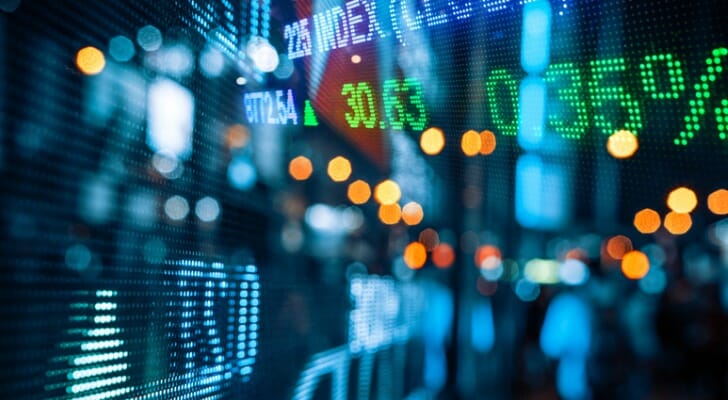Trading Dow Futures is a bit like making a color bet in roulette, where you are picking red or black instead of an individual number. Similarly, with a Dow Future contract, you are betting that the Dow Jones Industrial Average (DJIA) will go up or down rather than betting on a specific stock. Because the DJIA (also known as the Dow 30) can fluctuate wildly on any given day, trading Dow Futures can be very risky. That’s part of what makes futures more complex than investments such as stocks, bonds and mutual funds. But if you have some money to invest and a higher tolerance for risk, the upside of futures can be enticing.
Need help maximizing the returns of your investments? Consider working with a financial advisor.
What Is a Dow Future?
Like all futures contracts, Dow Futures are contracts between two investors that are traded on an options exchange. The exchange serves as the intermediary between the two individuals or institutions. The two parties in a Dow Futures contract basically bet on the direction the DJIA, one of the most widely used and reported on stock indexes in the U.S., will take on a specified day. This day is known as the “final settlement date.”
Early in the morning, you’ll see news reports about how Dow Futures are trading. This helps predict how the market will open. Dow Futures begin trading on the Chicago Board of Trade at 7:20 a.m. Central Time (8:20 a.m. Eastern Time), which is an hour and 10 minutes before the market opens. The ticker symbol for Dow Futures is YM.
How to Trade Dow Futures

Generally, you derive the value of a Dow Futures contract by multiplying the size of the DJIA by 10. If the DJIA is trading at 25,000, the contract is worth $250,000. There are also contracts available where the multiplier is 5 or 25. In turn, this would also impact the potential payout or loss.
When two parties agree to a Dow Futures contract, one party is betting that the value of the DJIA will go up while the other is betting that it will go down. On the final settlement date, whoever is wrong must pay the other party in accordance with the value of the Dow. The person selling the future makes money if the index goes down, while the person buying the future makes money if it goes up.
Consider a futures contract built around a DJIA value of 25,000 using the standard multiplier. Investor A sells the contract to Investor B. On the final settlement date, the DJIA is trading at 25,500. Using a multiplier of 10, this means that Investor A owes Investor B $5,000. On the flip side, if on the final settlement date, the DJIA is worth only 24,200, Investor B owes Investor A $8,000.
If you want to buy or sell Dow Futures, you’ll need an account with a futures broker, such as E*Trade.
Benefits and Risks of Dow Futures
When you buy a single stock, you are essentially placing a bet that you think that stock will go up in value, thus allowing you to sell it for a higher price than before. Or, if you take the short position on a stock, you are betting the price will go down, allowing you to buy it for a lower price than you sold it.
If you think the whole market is headed in one direction — or if you think some market event will be big enough to drive up or down the price of almost all of the biggest companies on the market — then buying or selling a Dow Future lets you bet on the entire market. This gives you the potential to make a lot of money if the market craters or soars.
Of course, if you are wrong, the opposite is true as well. You have the potential to lose a lot of money if the market craters or soars. Also, you have a legal obligation to take your losses. This is not true for regular stock purchases or an options contract either. If a stock drops, you’re under no obligation to sell your position. You can hold it to see if you break even or net a gain.
Should You Invest in Dow Futures?

Dow Futures can be a useful tool in the arsenal of an investor, but they are best reserved for veterans. People who have studied the market and understand what causes fluctuations are the most likely to have a good grasp on what the DJIA will do in the months ahead. Thus, they are the most likely to make an accurate prediction about what the Dow will look like on the final settlement date. Dow Futures probably aren’t the best choice for new investors.
Similarly, this is likely a tactic best used by investors who can swallow a potentially big loss. Whoever loses the contract must pay out. Depending on the change in the value of the DJIA and the multiplier, the payout could be steep. If you don’t have a high-risk tolerance when it comes to investing, less risky investments may make more sense.
The Bottom Line
Dow Futures are an investment strategy in which two parties take opposite positions on where the Dow Jones Industrial Average will be trading on a certain date. This is known as the final settlement date. The contract is legally binding and whoever is wrong must pay the other party. You can calculate the amount owed by multiplying the amount of the increase or decrease in the DJIA by a predetermined multiplier, generally 10.
Investors use Dow Futures to exploit what they see as potential big swings in the market. Because they’re risky, Dow Futures are generally best for experienced investors who can absorb a potentially big loss.
Tips for Investing
- Financial advisors often have years of experience in the investing world, making them great partners for anyone looking to improve their investment game. Finding a financial advisor doesn’t have to be hard. SmartAsset’s free tool matches you with up to three vetted financial advisors who serve your area, and you can interview your advisor matches at no cost to decide which one is right for you. If you’re ready to find an advisor who can help you achieve your financial goals, get started now.
- One of the most important investing basics is the principle of asset allocation. This involves diversifying your assets across multiple types of investments that are chosen based on your risk tolerance. To figure out what your portfolio should look like, stop by SmartAsset’s asset allocation calculator.
Photo credit: ©iStock.com/Fabrice Cabaud, ©iStock.com/guvendemir, ©iStock.com/Nikada
